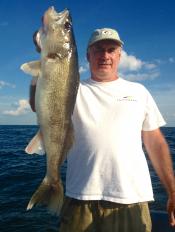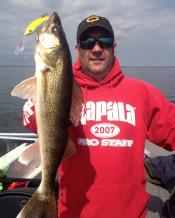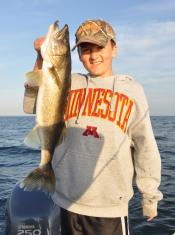 One of the keys to success for open water trolling is confidence and the ability to recognize patterns. How does one gain confidence? By being versatile and having an open mind. What crankbait worked last year or yesterday or in the morning may not work the best at the present moment. We as anglers are constantly challenged with so many changing variables that we never experience the same exact conditions when fishing.
One of the keys to success for open water trolling is confidence and the ability to recognize patterns. How does one gain confidence? By being versatile and having an open mind. What crankbait worked last year or yesterday or in the morning may not work the best at the present moment. We as anglers are constantly challenged with so many changing variables that we never experience the same exact conditions when fishing.
Joining me for a day of fun fishing on Mille Lacs were my friends Tim Ellis, Troy Rahn, Joe Cavanaugh and my son Ian. Due to the water temperatures still being in the mid 50’s, we knew that the majority of the walleyes were still relating to structure and that it was going to be a challenge finding them in the open basin. However, that didn’t stop us from trying and odds are if we covered enough water and invested time in scouting, we would eventually be rewarded. Finding the walleyes is one challenge, knowing which crankbait and color to use another challenge.
A recent study came out by the MN DNR stating that anglers spent $2.4B in MN during 2011. Of that, $1.4B was spent on equipment and the average amount spent per angler was $1537. More then ever, we have a lot of choices on how we spend our money on fishing. When it comes to selecting which crankbaits to buy for open water trolling, it can be overwhelming! They’re over one hundred lure manufactures and the crankbait profiles and colors are endless! How does an angler choose which one to use? Let’s see if we can break it down… First you need to answer the following questions:
Forage Base: What is the primary baitfish in your body of water? How big is that baitfish at this time of the year? Which crankbait profiles best match that baitfish and resembles the same swimming action? For example, tullibees are the primary baitfish that walleyes target in the open basin of Mille Lacs. Rapala Deep Tail Dancers #11, Storm Deep Thundersticks and Reef Runners (800 series) resemble a tullibee and have a similar swimming action.
Location/Time of Year:
Where is that baitfish located in your body of water on the day you are going to be fishing? You need to figure out and understand the patterns of the baitfish. I always say, if you find the baitfish, the walleyes are close by. It’s also important to understand the walleyes behavior when it come to location. Walleyes spawning peeks in the spring when temps are between 42-50 degrees. Due to the late ice conditions, I feel we are a good 2-3 weeks behind compared to a normal year. Many of the walleyes have not made their way back out to the open basin yet and they are still relating to structure and are spread out. We knew this going in on Sat. so we had to cover a lot of water scouting for a few fish. It was still early in the season and we would not be marking much on the sonar. Simply put, we were going to have to scout and then scout some more to find them. As the water temperatures increase, bug hatches will occur in different parts of the lake’s structure (mud, sand and gravel) which help congregate the baitfish and the walleyes will follow.
 Water Temperature: What is the water temperature and how does that affect where the baitfish will be located within your body of water that you’re fishing and where within the water column. Open water trolling picks up when water temps are over 60 degrees due to the congregation of baithfish and peaks when temps reach above 70 degrees.
Water Temperature: What is the water temperature and how does that affect where the baitfish will be located within your body of water that you’re fishing and where within the water column. Open water trolling picks up when water temps are over 60 degrees due to the congregation of baithfish and peaks when temps reach above 70 degrees.
Time of Day: Some baitfish will move up and down the water column over the course of a day. For example, tullibees feed up high in the water column at night and move down lower in the water column during the day due to the rise and fall of zooplankton, the amount of light and increasing water temperatures. Where you place your crankbaits within the water column should be dictated by the time of day.
The shape, size, swimming action, and noise made by the crankbait plays the most important role in capturing that walleye’s attention. Whether it strikes or not may be determined by scent and color. This is how I think – but no matter what, the crankbait must be trolled at the depth where you find those baitfish otherwise it doesn’t matter. Only then do I think about color. Again, there are so many choices out there in regard to color and every angler has their favorite. I try not to think that way because that is not being versatile. My favorite color is the last one I used to catch a walleye. In selecting a color of a crankbait, we first need to understand what factors affect color underwater. But before we do that, we need talk some basic physics. I feel Dr. Greg Vinall (Aquatic Scientist) explains color best:
"White light is made up of many different colored lights (wavelengths). When light strikes an object some wavelengths are absorbed and others are reflected. It is those wavelengths that are reflected from the object that reach our eyes and are interpreted by our brain as color. Objects that appear white to us are effective at reflecting all of the visible wavelengths of light. Conversely, objects that absorb all wavelengths and don’t reflect any appear to us to be black. Between the extremes, most objects absorb some wavelengths and reflect others and appear to our eyes to be colored. The color we see is the combination of all reflected wavelengths. Some wavelengths are absorbed off objects we see, others are reflected. It is the reflected wavelengths that are interpreted by our eyes as color.
 Color visibility at water depth
Color visibility at water depth
When white light passes through pure water the various wavelengths are absorbed at different rates. The long wavelengths (reds) are readily absorbed by the water molecules while the shorter ones (violets) are absorbed at a slower rate and penetrate further into the water. Put simply, what this means to Joe Average who likes to spend his weekends trolling is that some lure colors simply aren’t visible to a fish that is deeper in the water column. The longer wavelengths (reds and oranges) are absorbed nearest the surface, so at depth there aren’t any of these wavelengths to reflect off the lure. All other wavelengths are absorbed, so that color on the lure appears to the fish to be black, or at best may appear weakly colored by other wavelengths. As the lure dives further down in the water column yellow wavelengths start to disappear, then green. Blue, indigo and violet penetrate the deepest, but even these peter out eventually."
The way I remember it is by "ROYGBV" – Red, Orange, Yellow, Green, Blue, Violet
How does this apply in choosing a color of a crankbait for open water trolling? When I’m fishing higher in the water column, I usually like to use the first 3 colors – red, orange and yellow. When I’m targeting walleyes deeper in the water column, I like to use Green, Blue and Violet/Purple colors. On Sat., the walleyes we marked were very close to the bottom and a Deep Tail Dancer #11 in purpledescent ended up being the preferred color. Does this always work? No… but I feel it’s important to understand how color is viewed under water. I also like to use darker colors in low light conditions (cloud cover, morning, evening, stained water). A walleyes feeds up to attack its prey, and when there are low light conditions, I feel it’s more about how that crankbait compares to its background and those darker colored crankbaits will have the most contrast.
Chrome/Flash/Silver is the wild card in regard to color. As the sun rises and the amount of light penetrating into the water increases, I like to use crankbaits that give off more flash. When the light strikes that that crankbait it will reflect a long ways versus a solid color.
 There are many variables that affect the amount of light that hits your crankbait such as the sky conditions, angle of the sun, water clarity, water surface (a ripple to big waves) and time of day. The color of the water and structure (sand, gravel, mud, vegetation etc…) also plays an important role of how your crankbait contrasts to the background. I feel the more contrast – the better. And the more walleyes that can see your crankbait – odds are that one will eat it.
There are many variables that affect the amount of light that hits your crankbait such as the sky conditions, angle of the sun, water clarity, water surface (a ripple to big waves) and time of day. The color of the water and structure (sand, gravel, mud, vegetation etc…) also plays an important role of how your crankbait contrasts to the background. I feel the more contrast – the better. And the more walleyes that can see your crankbait – odds are that one will eat it.
What a walleye sees or just as important what it doesn’t see, may determine whether or not it strikes.
It’s simple to understand that the main reason why a walleye strikes a lure is because it’s hungry. However, I also feel that a walleye strikes even when they’re not hungry and does it simply out of a reflex action no matter their mood. As water temperatures rise, a walleyes reflex action increases and especially when the weather pattern has been stable. Speed triggers a reflex action. The walleye instinctively swims towards the crankbait and eats it simply because it can. That is how they are built and how they have survived for thousands of years. Walleyes feed on living organisms (baitfish, insects, zooplankton etc…) and don’t like to eat anything that’s not alive. Their instinct to eat live things is so strong that in a controlled environment, fish farmers incur very high mortality rates trying to get walleyes to eat artificial feed. They also witness cannibalism. I feel this reflex action is a big factor when trolling crankbaits out in the open basin. For this reason, I’ve never been able to pattern a specific time of day when the bite is best. Simply put, it can happen at any time.
Competition is another reason why a walleye strikes a lure. When site fishing for any fish species, we’ve all witnessed multiple fish increase their speed as they approach your offering. I believe this also happens in the open basin and is another reason why a walleye strikes your crankbait.
Keeping an open mind and being versatile was a big reason for our success on Saturday. We knew it was just a matter of time that we would put the pieces of the puzzle together. Understanding the preferred baitfish, knowing which crankbait profiles to choose from and how colors are viewed underwater will help you put fish in the boat!
If you’re interested in learning how to catch open basin walleyes, check out my website at www.openwatertrolling.com and consider attending one of my Open Water / On the Water Trolling Clinics. I’ll be back at it again over Father’s Day weekend. With the warmer air temps that are forcasted this week, the water temps should increase as well and more walleyes will move out to the open basin. It’ only going to get better! If you have any questions, please feel free to send me a PM or an email. As always, I’m happy to help out.
Until next time – keep trollin’!
A few more pictures…
Great read and info on color variations
great read
I think Joe catches more “overs” in a season than the average person catches in a lifetime on Mille Lacs. He must be really lucky or know how to catch them.
Nice fish and interesting read Brad!
Brad, you never stop amazing me! Nice work getting on the board/lead bite this ealry!! I tried it a little last weekend and only got 2 pike out of 32′ of water. Fish are starting to show up out there though.
Thanks Fife, probably lucky to have a friend with a Skeeter
who finds those big walleyes for us. I had one job (reel!),
glad I didn’t f’ it up. LOL, Joe C.
Great report – I can’t wait to get out this weekend!!!
Also, great pic of you and Ian!
Thanks, This was a great read and cant wait to try it out.
Very nice job.
Excellent detail and Report,
Thanks Brad,
Jack
Great report with good info.